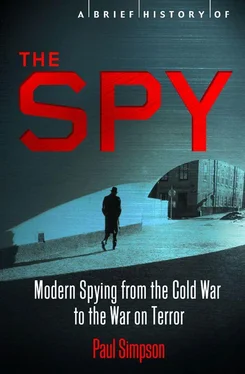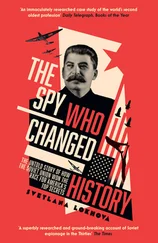Paul Simpson - A Brief History of the Spy
Здесь есть возможность читать онлайн «Paul Simpson - A Brief History of the Spy» весь текст электронной книги совершенно бесплатно (целиком полную версию без сокращений). В некоторых случаях можно слушать аудио, скачать через торрент в формате fb2 и присутствует краткое содержание. Город: London, Год выпуска: 2013, ISBN: 2013, Издательство: Constable & Robinson, Жанр: Прочая документальная литература, на английском языке. Описание произведения, (предисловие) а так же отзывы посетителей доступны на портале библиотеки ЛибКат.
- Название:A Brief History of the Spy
- Автор:
- Издательство:Constable & Robinson
- Жанр:
- Год:2013
- Город:London
- ISBN:9781780338910
- Рейтинг книги:3 / 5. Голосов: 1
-
Избранное:Добавить в избранное
- Отзывы:
-
Ваша оценка:
- 60
- 1
- 2
- 3
- 4
- 5
A Brief History of the Spy: краткое содержание, описание и аннотация
Предлагаем к чтению аннотацию, описание, краткое содержание или предисловие (зависит от того, что написал сам автор книги «A Brief History of the Spy»). Если вы не нашли необходимую информацию о книге — напишите в комментариях, мы постараемся отыскать её.
A Brief History of the Spy — читать онлайн бесплатно полную книгу (весь текст) целиком
Ниже представлен текст книги, разбитый по страницам. Система сохранения места последней прочитанной страницы, позволяет с удобством читать онлайн бесплатно книгу «A Brief History of the Spy», без необходимости каждый раз заново искать на чём Вы остановились. Поставьте закладку, и сможете в любой момент перейти на страницу, на которой закончили чтение.
Интервал:
Закладка:
During his time in Berlin, and later Frankfurt, Hall provided documents regarding electronic eavesdropping operations carried out by the Americans to Yildirim or KGB officers, and was paid in dollars or German marks. There was concern at the time of his arrest that Yildirim might have been running a spy ring out of the Berlin Field Station: ‘We are looking at the potential — and it’s so far just potential — that this could be the Army’s Walker case,’ one investigating officer said, during preparations for Yildirim’s trial; current assessments agree that Hall caused as much damage during his six years as Walker did in eighteen.
Hall admitted that he delivered between thirty and sixty documents to his handlers, which led to a programme designed to exploit a Soviet communications vulnerability uncovered in the late seventies being rendered useless, as were plans to disrupt electronic commands and surveillance. ‘Without commenting on the specifics, it appears that Hall did very serious damage,’ Senator David Boren, chairman of the Senate Intelligence Committee, said at the time. Some of the material he provided, such as the National SIGINT Requirements List, enabled Stasi spymaster Markus Wolf to ‘take relevant countermeasures’ against American plans.
Hall was court-martialled and sentenced to forty years’ imprisonment; Yildirim received a life sentence, with the FBI telling his lawyer in 1997 that they ‘think it is not inappropriate for him to rot in prison. They say his work might not have caused physical harm to Americans, but he hurt a lot of Americans by contacting them, so that they lost security clearances and ruined their careers.’ He was, however, released in 2004, and on his return to Turkey, boasted of his affairs during his spying missions.
Huseyin Yildirim was by no means the first spy to brag about his career after retiring or being forcibly removed from the game. Robert Hanssen claimed that he was inspired as a child by Kim Philby’s interesting take on his career in his book My Secret War (although this was clearly another of Hanssen’s fabrications: he was actually twenty-four when the KGB spy’s book was published). Some career retrospectives have become the authoritative sources on events — Victor Cherkashin’s book on handling Ames and Hanssen provides perspective that no one else could have had; Oleg Gordievsky’s account of his interrogation shows the way in which the KGB operated against one of their own. One book, however, became the cause of considerable problems for the British government.
MI5 officer Peter Wright’s Spycatcher attracted considerably more attention as a result of the government’s actions than its not particularly well-written pages deserved. After his retirement in 1976, embittered at being awarded a lower pension than he felt he deserved, the former MI5 agent moved to Tasmania and cooperated with British writer Chapman Pincher’s exposé of British intelligence in Their Trade is Treachery , published in 1981. This rehearsed Wright’s beliefs that Sir Roger Hollis had been a KGB agent. He then appeared in a World in Action television documentary on 16 July 1984, publicly accusing Hollis. Both were in breach of his obligations under the Official Secrets Act and an agreement on his retirement ‘never to disclose anything I knew as a result of my employment, whether classified or not’.
Wright worked on his own book, and although some publishers were put off by warnings from the government, Heinemann decided to put the book out through their Australian subsidiary. Determined to stop it by whatever legal means necessary, the Attorney General, Sir Michael Havers, began proceedings in Australia. This unfortunately meant that Havers had to admit, solely for the purposes of the court case, that Wright’s allegations were accurate. This undermined the case for publication not being in the public interest, particularly since Hollis had helped to set up the Australian security service, the ASIO.
The government’s case wasn’t helped by its official position that it still refused to acknowledge the existence of MI6 — which led to a surreal moment where Sir Robert Armstrong had to agree that the service had existed while Sir Dick White was head of it (since he had volunteered that information in an earlier answer), but could not admit it had any prior or subsequent existence! Many agreed with Wright’s co-author, World in Action director Paul Greengrass’ assessment of the case: ‘It became a great set-piece encounter — conflict, really — trying to define where the boundaries lay between the government’s desire to protect national security and our right as citizens to know what is done in our name.’ Unsurprisingly, the government lost the battle, and Spycatcher , with its allegations about a plot against Harold Wilson, and considerable manipulation of the facts, was published in Australia and America.
Apart from allowing an insight into the mindset of some of those employed by MI5 during the height of the Cold War, the Spycatcher Affair did have one very important consequence: it was clear that it was impossible for the government to continue maintaining that the security services MI5 and MI6 didn’t exist. The Security Service Act of 1989 was the first in a number of Acts of Parliament that eventually put both services on a full constitutional footing.
Greengrass later went on to great fame in the fictional spy world as director of the second and third films based on Robert Ludlum’s spy Jason Bourne, as well as the drama documentary United 93 , about the third plane involved in the 9/11 hijackings.
The first major Eastern bloc spy captured in Britain after the expulsion of the twenty-five Soviet illegals identified by Oleg Gordievsky was Dutchman Erwin Van Haarlem. He only came to light when MI5 followed a member of the Soviet Trade Delegation whom they (probably wrongly) suspected of being a GRU officer and saw him behave furtively on Hampstead Heath before entering a local pub. Half an hour later a second man searched an area of ground on the heath before entering the same pub. MI5 followed this other man and identified him as Van Haarlem, a self-employed art dealer, who was actually in Britain working for the Czech secret service.
Special Branch raided Van Haarlem’s flat on 2 April 1988, and caught him red-handed, in the middle of receiving a transmission from Prague. He admitted he was Czech, and produced his one-time cipher pads. One of the main witnesses at his trial was future MI5 head Stella Rimington (referred to as Miss J) who explained that MI5 believed Van Haarlem was a sleeper agent, ready for a front-line role in time of war.
It turned out that Van Haarlem wasn’t the spy’s real name, even though an Erwin Van Haarlem had been abandoned in Prague, aged six weeks, in 1944. The baby’s mother had tracked the man down using that name in 1978 and he had pretended to be her son. However, DNA testing proved that they were not in fact related: the spy had adopted the name prior to leaving Czechoslovakia in 1974.
The judge at his trial, at which he was found guilty of committing an act preparatory to espionage, noted, ‘I address you by the name Van Haarlem, although I am convinced it was not yours at birth,’ adding, ‘I have not the least doubt you are a dedicated, disciplined and resourceful spy and I have equally no doubt that had you not been caught you would in future years have done whatever your Czech controllers required you to do, however harmful that might have been to our national interests. Those interests and freedoms we must jealously guard.’ He was sentenced to ten years in prison in 1989, but was deported to Prague after serving five. MI5 discovered his true name was Václav Jelinek; the real Van Haarlem was eventually reunited with his mother, unaware that his identity had been stolen after he had changed his own name some years earlier.
Читать дальшеИнтервал:
Закладка:
Похожие книги на «A Brief History of the Spy»
Представляем Вашему вниманию похожие книги на «A Brief History of the Spy» списком для выбора. Мы отобрали схожую по названию и смыслу литературу в надежде предоставить читателям больше вариантов отыскать новые, интересные, ещё непрочитанные произведения.
Обсуждение, отзывы о книге «A Brief History of the Spy» и просто собственные мнения читателей. Оставьте ваши комментарии, напишите, что Вы думаете о произведении, его смысле или главных героях. Укажите что конкретно понравилось, а что нет, и почему Вы так считаете.












